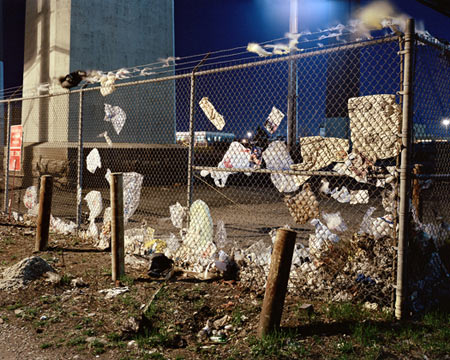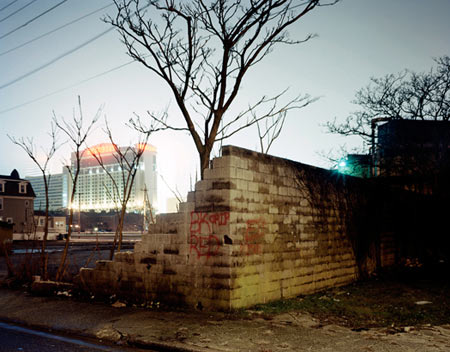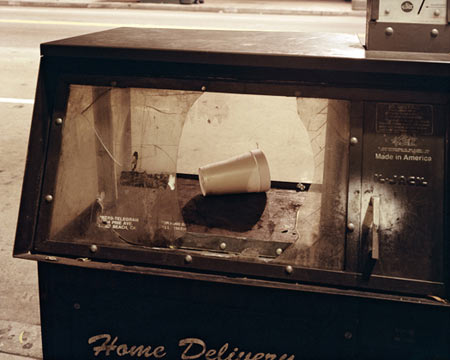A conversation with Will Steacy

Will Steacy’s current project is called “Down These Mean Streets”, and to take the photos, he hiked from the airport to the central business district of the cities he was photographing - at night, equipped with a large-format camera. This is not something photographers do all the time - so I approached Will to find out more about his work.
Jörg Colberg: For “Down These Mean Streets” you are lugging a large-format camera into inner cities at night. My first question is actually maybe a little bit stupid, but here goes anyway: Why at night? Do you need the added thrill of nighttime making things a bit more scary? What is there to see at night that you don’t see during the day?
WS: One of my favorite Ernest Hemingway quotes is, “I know the night is not the same as the day: that all things are different, that the things of night can not be explained in the day, because they do not then exist.” And this is very true. The night is very important to this work on many levels. I believe that fear is one of the main factors that has contributed to the current condition of America’s inner cities and by working at night I wanted that visual element and its associations, fear, etc, to be a part of the mix. Many have questioned why it is I have chosen a large format camera to do this work. No, I am not some thrill seeker or on a suicide mission. And yes, there have been times when I am afraid and my own fear plays a part in the picture making process, in some ways it is a guide. I question why I am afraid, what makes me feel this way, the group of guys standing on that corner, the figures running in and out of the shadows over there, the homeless, the drug addicts, the mentally ill, having this camera on my shoulder and something to loose? What are we afraid of, have our fears been conditioned, is it OK to be afraid? I actually feel the most safe with this big guy on my shoulder. Walking around with this camera does several things. First off, my intentions are clear, I have committed to lug around what looks like to most some big wooden antique flea market camera, I make myself clear, there will be no surprises, there will be no quick getaways. I basically serve no threat. And with that said, the people who perhaps most might be “afraid” of at night I think see me as a crazy person because no “normal” person would go walking around these parts at night with that thing, and this gets starts to get into stereotypes which are significant when discussing fear, but a whole other conversation. There are many things I have learned from these walks about the unwritten and accepted rules of society, people, places, race, class, boundaries, codes of respect, etc and I could sit here for hours talking about my experiences, but the main thing I have come away with from this work, is really quite simple, people are people and often times that is something that gets overlooked.

JC: I’m wondering whether this kind of reflex triggered by seeing those places at night might not get in the way of your audience noticing what you’re after? How can you make people ignore the fact that you went there and took those pictures and came back in one piece - as much as that’s part of the process - and look at what those inner cities actually look like?
WS: I don’t want people to ignore the fact that I went to certain areas of our cities to make these photographs. No way! The location of the photograph is very important, it is the subject of the work. But the fact that I was where I was when I made the photograph is not the subject, this work is not a personal travel diary. Nor are a war photographers images. Yes, the war photographer has been to some pretty crazy places and been in some tight situations but that is a part of the work. The photographs are about war, and while some bullets may have been dodged and that certainly is interesting, the photographs speak about a larger cause, something bigger and greater than any individual. No matter how many bullets one man dodged, war will always remain the larger issue, no matter how many close calls I had out in the streets late at night, the American city will always be greater. Sometimes a photographer is like an ancient long distance runner traveling at great depths and personal sacrifice to relay the message of his tribe to another tribe, working selflessly for a larger greater cause.

JC: I sense a bit of romanticism in “Down These Mean Streets”. Not the kind of flowers in a meadow romanticism, but the other kind that’s often to closely related to artists and their way of life. Absurd? Are you a romantic at heart?
WS: I was brought up with a working class work ethic. Whether it was school and homework (which I despised, but with a mother who was a teacher, I could run but never hide) or playing baseball, I was taught to pour my heart and soul into what I did. If I was going to do something, I gave all of myself. Growing up in a city (Philadelphia) that prides itself and its sports figures on having heart and balls and being tough, I never had to look far for inspiration or role models. I throw myself into my pictures, the projects I embark on I believe in and am fully committed to, I will risk anything and do whatever I need to do to make this work and follow this thing inside me. I may fall flat on my face, but I will fall hard and with everything I have and I will keep picking myself up and going at it until I have fallen so many times that I am blinded by the blood running into my eyes. That’s Philly, that’s how my mother raised me and that’s the only way I know how.
I am passionate about my work and I approach the photograph making process with the same heart and toughness that I did when playing sports or working construction. Inevitably this method of working which allows me to make the pictures I need to make also means that I leave a part of myself in the pictures I take. This is something I fully embrace and one of the reasons I fell in love with photography. There is great beauty in the making of the photograph and the translation and abstraction of my experiences and interactions onto film. So, yes, in some regards I guess I am a Romantic, I have a big heart and for better or worse I lay myself out on those railroad tracks and allow that runaway locomotive (the world) to hit me at full speed. However, my work is not all about me, I don’t want it to be about me. In the process of piecing together the story I am telling of course a piece of me ends up in the story. It always does. No matter who is telling the story, the storyteller will always be there. I think most photographs (with exception to appropriated images and other work of conceptual nature/technique, etc), by default have a part of the photographer in them, it is the photographer who chooses at that particular moment to expose light onto film (or sensor) in an edited and framed composition of the world.
Perhaps what you are hinting at is how much of “Down These Mean Streets” is about me. Early on in the project, the boundaries where questioned, how much of this work is reportage and how much of the project is about me walking around at night in bad neighborhoods with this camera of mine. I thought long and hard about the work, what I was showing and how I was showing it. The more I thought about it I realized that if I never told people how they were made, then my end goal might not be realized, I want people to see what has become of our inner cities, what we have allowed to happen, what we have accepted. By describing the geographic areas that I have been wandering and photographing, people are able to understand on a personal level and understand the work through themselves, and this is exactly what I want, I want people to put themselves on that corner at 3am. Most immediately respond, isn’t that dangerous, are you crazy, etc, because they are vaguely familiar with these parts of town and are able to envision themselves in these circumstances, people see the world through themselves. I want my viewers to be intimately familiar with the American inner city and challenge people to look inward.

JC: However, most people would probably not put themselves at a corner in their own safe neighbourhood at 3am, let alone at one in one of those inner cities. But I need to get back to the idea of night and of the added thrills of the night (and there are many). Those inner cities are places where people live, and they are the places where most cities’ actual life used to happen before everybody fled (something that, for example, Philip Roth wonderfully described). You talked about fear earlier, and it would seem to be that to address fear one would have to have a look in broad day light, when everything and everybody is out in the open: Here, have a look at this, this is where these cities’ life used to be before we let it go to waste. And in a way, that’s even scarier at night for many people, but isn’t it already bad enough during the day? Doesn’t taking photos at night play into the fear, maybe in ways that would run counter to what you’re trying to achieve?
WS: The difference between the day and night is night and day. Just as Phillip Roth is to Eli Roth, Eli Whitney to Whitney Houston, Houston Texas to The Bronx. I think people have become numb to the “day” just as when you watch the 6 O’Clock news, at times it seems like just another murder, just another arrest, etc and its too easy to then flip to Law and Order during a commercial break without any emotional boundaries or separation from what was just reported to fiction, the realities of our streets and cities have become just another show. Our country has a warped vision of its urban areas; the lines between the media’s representation of reality in inner cities and the fictional events depicted in entertainment have become blurred. Our cities have been neglected and the problems and issues that plague them have been swept under the carpet and left for another day and this has gone on for far too long. There needs to be a modern day portrait of the American inner city which people can’t easily overlook or forget about, something that isn’t just another show, something they haven’t seen before, something that registers and is able to create a sense of empathy somehow. These are my goals and intentions with this work.

JC: When I look at your photography, it seems to divide into what you shot before and after Hurricane Katrina. Katrina looks like a dividing line. How do you feel about this? Did Katrina affect you in ways that afterwards, photography, taking photographs, wasn’t the same any longer?
WS: I completely agree. The year that I spent photographing in New Orleans challenged me like never before and awakened something inside me. I saw the power and potential of the photograph and its ability to create awareness. In 2003 I was almost murdered in a robbery and that experience had a profound impact on me personally and as an artist. Coming that close to death allowed me to see what I understand as my purpose in life, to follow my art, this thing inside me that fought so hard to live that night. The next year or so of my life was very hard and it took me a long time to come to terms with things and to move forward in a positive way. The closest to death I have come since that night was in New Orleans. When I made my first trip there several weeks after the flood the city was a ghost town and death filled the air in every possible way, from dead bodies, animals to questions about what was going to happen to this city and the lives of its residents. I feel as though my own experience allowed me to see and understand this disaster in a unique way. I had tremendous respect for the resilient spirit of those who came home and who fought back, who fought so hard to put back their lives piece by piece after losing everything.
I don’t think America will ever truly understand what happened in New Orleans. And is still happening today. I was so overcome by the crimes, devastation and the pain that I witnessed in my first trip there, I had never seen anything like that before in my life, and I felt something take over me. This thing that swept inside me that night in 2003 and told me it was not my time to die, that I had not yet done what I was put on this Earth to do as I had a gun to my head, awoke within me. This thing, this spirit, I can’t really describe it in words because there are none, perhaps my art is the best word to use, but this thing came alive in me during my work in New Orleans. I devoted everything I had to that work and to putting it in front of urban planners, Ph.D. students, film producers, editors, doctors, curators, writers, students, journalists, disaster planners, community organizers, artists, talk show hosts, etc and to show them what was happening, what the conditions were, etc. I saw the photograph as a way to help envision the future and to spark action and plans for change. And this thing that saved me that night, that I have given myself to, has never left. If it does, then it will be time for me to put down my camera.

JC: Let’s talk about portraiture a little bit. What interests you in portraiture? Why do you take portraits?
WS: When I take a portrait I ask my subject to give a part of him/her self to me. And that I will do the same. We will dance. When it’s over there will be a picture. When I am making a portrait I am looking for that moment when my subject has shed the normal everyday boundaries that we put up to the world and has allowed me inside. This moment usually only lasts for a short time before they become self aware and those boundaries go back up. I want you, I want to be inside you, with your thoughts, dreams, memories, the place you go that is all yours and no one else can come in, I want to be invited in. I think that at some of our most inward moments in which we are so far gone with ourselves and we have drifted off into our own place are some of the times when we are the most alive and truly human.
Q: And how do you decide about the people you want to take a portrait of?
A: I am pretty loose really. In a lot of my favorite portraits, my subject has just walked right up to me, they have come to me. I mean I’ve had people who said they were going to rob me and then somehow ended up taking their portrait. I have had people share with me very personal things, things that I don’t know would happen if the camera was not there, the camera can be a wide open doorway into the room in the attic that has always been locked. In Memphis I was in the middle of taking another photograph when I look over and I watch this kid just slowly moving towards me. It was magnetic. And as soon as I saw this kid I knew I had to take his picture. He came up to me and just stood there, staring at me. I was like holy shit I have to take this kids picture right now! He nodded when I asked him if I could take his portrait and I got under the dark cloth, and there it was. This kid who barely said a word to me, instantly let me in, and gave himself to me. I took two sheets and that was it. One of the things that I love so much about photography is the act of discovery. It’s all about that dance and I’m blind baby, I don’t care who I dance with, I just want to dance.
“Down These Mean Streets” is on view at NYU’s Gulf and Western Gallery from June 4th until August 8th.
 By
By